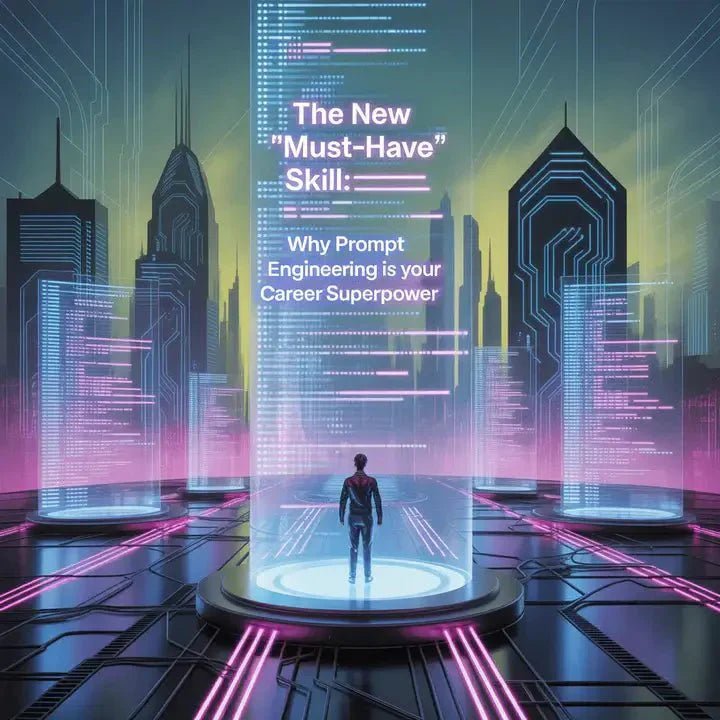
Mastering Prompt Engineering: The Career Skill You Need for 2025
🚀 Why Everyone Talks About AI — But Few Use It Well
AI is everywhere. From marketing to healthcare, finance to education, 70% of companies are already experimenting with AI (McKinsey, 2024).
And yet — fewer than 10% of employees feel confident using AI tools effectively in their daily work.
👉 This mismatch between adoption and proficiency is not a problem. It’s your biggest career opportunity.
You don’t need to learn complex coding languages or become a data scientist. The real unlock is Prompt Engineering — the ability to communicate with AI so it delivers precise, valuable, and actionable results.
The World Economic Forum predicts that by 2025, critical thinking and analysis will be among the most in-demand skills globally. Prompt engineering is exactly that: structured thinking + creative problem-solving.
🚧 The Problem: Why You’re Not Getting Great AI Results
Most people use AI like Google:
“Write me a blog post about marketing.”
The output? Generic. Forgettable. Useless.
Why? Because AI doesn’t think like a person. It needs:
Context (who is speaking?)
Specificity (what exactly do you need?)
Constraints (what’s the format, style, or limit?)
Without these, you’re only scratching the surface of what AI can do.
💡 The Solution: The 6-Step PROMPT Framework
A simple, repeatable system for turning vague requests into laser-focused instructions that get great results.
P – Persona → Tell the AI who it is.
Example: “Act as a senior marketing strategist with 15 years of experience.”
R – Role/Task → Define the job clearly.
Example: “Your task is to create a blog post outline on the future of email marketing.”
O – Objective → Clarify the goal.
Example: “The objective is to engage small business owners and persuade them to adopt automation tools.”
M – Methodology → Specify format & style.
Example: “The outline should have an intro, 3 main sections with supporting data, and a conclusion.”
P – Parameters → Set boundaries.
Example: “Tone: professional but accessible. Each section under 150 words.”
T – Topic → State the subject.
Example: “The future of email marketing.”
📈 Why the PROMPT Framework Works
Using this structure ensures:
✅ Clear role & context → AI acts like an expert, not a generalist.
✅ Defined success → Fewer revisions and wasted time.
✅ Relevant, persuasive outputs → Immediately usable.
As Harvard Business Review notes, the employees who can “translate” business needs into AI instructions will be the most valuable productivity enablers in the next decade.
🔮 The Career Advantage of Prompt Engineering
In a world where AI tools are commodities, the differentiator is how you use them.
Mastering prompts turns you into:
-
⚡ Faster → Producing high-quality work in minutes.
-
🎨 More creative → Generating innovative solutions consistently.
-
🌟 Indispensable → Becoming the “AI go-to” in your team.
And it applies everywhere:
Marketing: better campaigns & copy.
HR: smarter job descriptions.
Sales: personalized pitches.
Design: more creative briefs.
Operations: optimized workflows.
✅ Your Next Step
Take the PROMPT framework and apply it to something you’re working on today:
Write an email,
Draft a social post,
Outline a presentation.
You’ll notice an immediate jump in clarity and quality.
This isn’t just about better prompts. It’s about building one of the most valuable career skills of the next decade.
👉 “Want to see prompt engineering in action? Check out AI for Shopify.”
👉 “Curious how prompts can power your content strategy? Read AI Content Creation.
❓ FAQs on Prompt Engineering
1. Is prompt engineering just for tech jobs?
No — it’s useful in marketing, HR, sales, design, education, and beyond. Anywhere you use AI, prompts matter.
2. Do I need coding to learn this?
Absolutely not. Prompt engineering is about clear thinking and communication, not programming.
3. Can prompts really improve AI that much?
Yes. The difference between a vague request and a structured prompt is often the difference between unusable fluff and publish-ready content.
4. Are frameworks like PROMPT universal?
Yes — you can adapt it for any tool (ChatGPT, Claude, Gemini, Jasper, etc.).
5. How do I practice?
Start by rewriting one of your last 3 AI prompts using PROMPT. Compare results. That’s your first lesson.